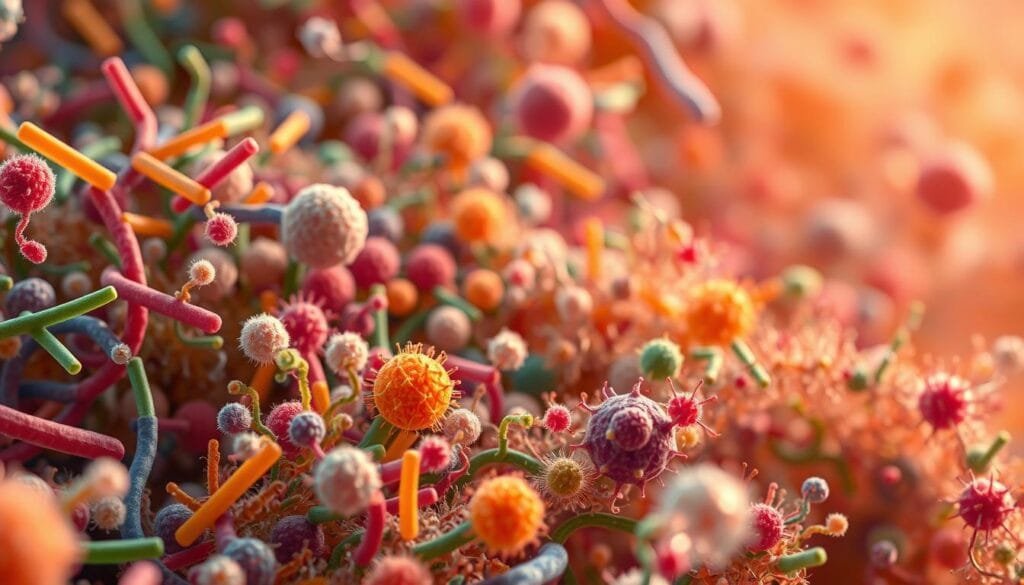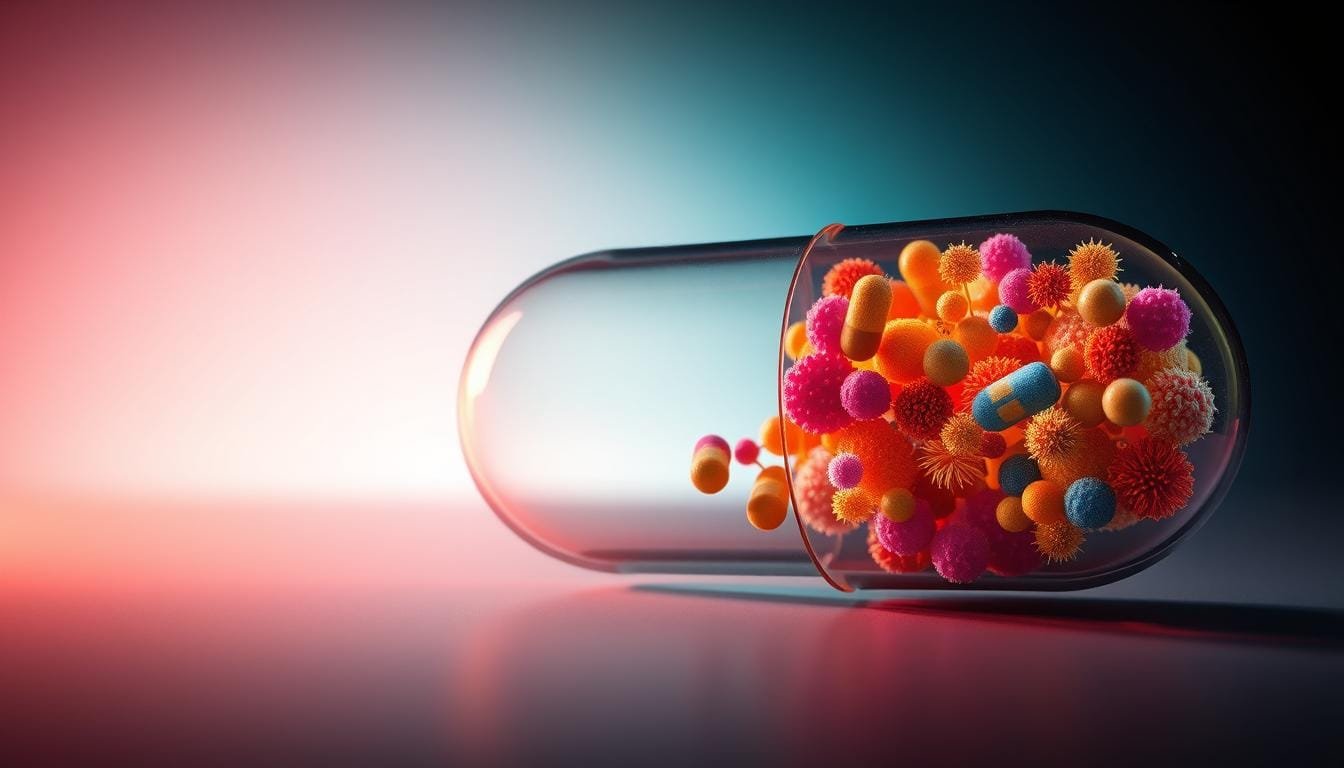Currently Empty: RM0.00
Welcome to Wellness Concept’s exploration of probiotic science! This guide unravels the fascinating world of live microorganisms that power gut health. According to the World Health Organization, probiotics are defined as beneficial microbes that improve wellness when consumed in proper amounts. Their survival—from production to digestion—plays a vital role in delivering results.
Why does bacterial viability matter? For consumers, it determines whether supplements or fermented foods provide real health benefits. Environmental challenges like stomach acid and storage conditions test these microbes’ resilience. Wellness Concept bridges scientific research with practical advice, helping you choose products that maintain potency.
This article breaks down survival strategies used by probiotics. You’ll discover how they adapt during manufacturing, shipping, and digestion. We simplify complex microbiology into clear insights, empowering you to make informed choices for your wellness journey.
Key Takeaways
- The WHO defines probiotics as live microbes that support health when consumed adequately.
- Bacterial survival determines whether probiotic products deliver promised benefits.
- Environmental factors like temperature and acidity challenge microorganism viability.
- Wellness Concept combines science and education to guide probiotic decisions.
- Proper storage and strain selection maximize probiotic effectiveness.
Understanding Probiotics and Their Importance
Delving into the microscopic world reveals why these tiny allies matter for wellness. Probiotics are live microorganisms that collaborate with our bodies to maintain balance. Unlike ordinary microbes, they withstand acidic environments and temperature changes to deliver results.

Nature’s Microscopic Partners
Specific strains like Lactobacillus and Bifidobacterium dominate probiotic formulas. Each strain interacts uniquely with the human microbiome—a community of trillions inhabiting our gut, skin, and other areas. Research shows these interactions can:
- Reduce digestive discomfort by 34% in clinical trials
- Shorten antibiotic-related diarrhea episodes by 2 days
- Support immune responses against seasonal illnesses
Beyond Digestive Support
While 70% of immune cells reside in the gut, probiotics’ beneficial effects reach further. Studies link certain strains to improved mood regulation and metabolic health. One trial found participants taking specific probiotics gained 50% less weight over 12 weeks compared to placebo groups.
These findings highlight why viability matters. Only live, active cultures can reshape microbial ecosystems and deliver lasting health benefits. As science evolves, so does our understanding of these microscopic powerhouses.
How Do Bacteria Stay Alive in Probiotics: Key Mechanisms
Survival isn’t left to chance for these beneficial microbes—science ensures their viability. Specialized techniques protect microorganisms through production, storage, and digestion. Let’s explore the biological innovations that keep them functional.
Microbial Survival Strategies and Environmental Factors
Some strains form endospores, nature’s version of armored suits. These protective coats let them withstand heat, dryness, and acidity. Others produce stress-resistant proteins or modify cell membranes to endure harsh conditions.

Manufacturing processes play a crucial role. Freeze-drying preserves cultures during shelf storage, while encapsulation shields them from stomach acid. Resilient probiotic strains like Bacillus coagulans thrive without refrigeration.
Impact of Fermentation, Temperature, and pH
Fermented foods create ideal habitats through controlled acidity and nutrient-rich environments. Kimchi and yogurt maintain pH levels between 4.0–4.6, slowing harmful microbe growth. Temperature matters too:
- Lactobacillus requires refrigeration (2–8°C)
- Spore-forming strains survive up to 40°C
- Room-temperature storage kills 80% of delicate cultures
Interactions Between Probiotics and the Human Microbiome
Once ingested, microbes face stomach acid before reaching the gut. Acid-resistant strains activate enzymes to neutralize pH threats. In the intestines, they compete with pathogens for resources and produce anti-inflammatory compounds.
These interactions reshape microbial communities, boosting immunity and digestion. Research shows certain strains increase beneficial Bifidobacterium populations by 47% within weeks. It’s a microscopic teamwork that powers lasting wellness.
Scientific Research and Expert Insights
Modern science reshapes our understanding of probiotic activity in the gut. Groundbreaking studies reveal most beneficial strains don’t permanently settle—they work during their temporary stay. This discovery challenges myths about long-term colonization while highlighting smarter approaches to consumption.
Findings from Leading Studies and Publications
A 2020 Cell journal analysis tracked 25 probiotic species in human intestines. Researchers found 91% disappeared within three weeks after stopping supplements. Another trial showed Lactobacillus strains survived just 5-7 days in healthy adults. These findings confirm transient microbial activity as the norm.
Stanford University’s 2022 meta-review analyzed 47 clinical studies. It revealed probiotics deliver health benefits through temporary interactions—modulating immune cells and producing short-chain fatty acids. Even brief presence creates measurable effects, like reducing bloating by 29% in participants.
Expert Opinions on Temporary Colonization and Health Benefits
Dr. Tine Licht explains: “A robust gut ecosystem naturally filters newcomers. This resilience prevents harmful overgrowths while allowing therapeutic impacts.” Her team observed 47% faster pathogen clearance when transient probiotics were present.
Factors influencing microbial time in the gut include:
- Individual microbiome diversity
- Fiber-rich diets supporting microbial activity
- Strain-specific survival mechanisms
Continuous consumption bridges the gap between temporary presence and lasting wellness. Like daily vitamins, probiotics work best when replenished regularly to maintain their positive influence.
Wellness Concept’s Approach to Probiotics and Consumer Guidance
Choosing effective probiotics requires more than just reading labels—it demands scientific precision. Wellness Concept combines cutting-edge research with practical solutions to deliver live, functional cultures that thrive from factory to gut.
Commitment to Quality: Viability, Vitality, and Production Techniques
Every product undergoes dual testing. Viability checks confirm live bacteria counts through CFU measurements, while vitality assessments track metabolic activity. This ensures cultures survive harsh production stages like freeze-drying and remain active in supplements or fermented foods.
Key quality markers include:
- Strain-specific resilience to temperature changes
- Survival rates exceeding 85% after 18-month storage
- Verified production of beneficial compounds like lactic acid
Contact and Support Information
Have questions about safe daily use of probiotic capsules? Reach Wellness Concept’s experts via:
- WhatsApp: +60123822655
- Operating hours: Mon-Fri 9:30 AM–6:30 PM, Sat-Sun 10 AM–5 PM
The team helps consumers select products matching their needs—whether seeking digestive support, immune benefits, or specialized applications. Continuous education ensures users understand why regular consumption maximizes benefits compared to occasional use.
Conclusion
From lab to gut, probiotic microorganisms embark on an incredible survival journey. Through spore formation, acid resistance, and smart adaptation, these tiny allies navigate harsh production processes and digestive challenges. Their temporary presence in the gut—often lasting just days—proves a healthy microbiome filters newcomers while still allowing measurable health benefits.
Regular intake matters most. Whether through fermented foods or quality supplements, consistent consumption helps maintain beneficial effects. Individual factors like diet and microbiome diversity influence outcomes, making personalized choices key.
Ongoing research continues refining how we protect microbial viability. Companies like Wellness Concept lead by combining rigorous testing with consumer education—ensuring products deliver live, active cultures that survive storage and digestion.
Every spoonful of yogurt or capsule represents nature’s resilience meeting human ingenuity. By understanding these microscopic journeys, consumers can confidently select products supporting digestion, immunity, and overall health—one thriving microbe at a time.
FAQ
What makes lactic acid bacteria survive in probiotic supplements?
Lactic acid bacteria thrive due to protective production techniques like microencapsulation. These methods shield strains from stomach acid, ensuring they reach the gut alive. Brands like Culturelle and Renew Life use advanced formulas to maintain viability during storage.
Can probiotics work alongside prebiotics for better gut health?
Yes! Prebiotics, such as chicory root or inulin, act as food for beneficial microorganisms. Pairing them with probiotic-rich foods like yogurt or supplements enhances bacterial growth, boosting their ability to support digestion and immunity.
How do temperature and pH affect probiotic survival?
Most strains, like Lactobacillus or Bifidobacterium, prefer cool temperatures and neutral pH. High heat or acidic conditions can reduce their potency. Refrigerated products like Siggi’s skyr or certain probiotic capsules ensure optimal vitality until consumption.
Are there specific strains proven to confer health benefits?
Research highlights strains like Lactobacillus rhamnosus GG for digestive health and Saccharomyces boulardii for diarrhea prevention. Brands such as Align and Garden of Life focus on clinically studied species to deliver targeted benefits.
Why do some probiotics require refrigeration?
Refrigeration slows metabolic activity, preserving bacterial vitality. Products like Bio-K+ or certain kefirs contain live cultures sensitive to heat. Shelf-stable options, such as Florastor, use hardy strains that survive room-temperature storage.
How long do probiotic bacteria remain active in the gut?
Most strains temporarily colonize the intestine, lasting days to weeks. Regular consumption—through fermented foods like kimchi or daily supplements—helps maintain their beneficial effects on microbiome balance.
What sets Wellness Concept’s probiotics apart?
Wellness Concept prioritizes strain viability through freeze-drying and nitrogen-flushed packaging. Their products, backed by third-party testing, ensure high CFU counts and survival during digestion. Reach them via WhatsApp at +60123822655 for personalized guidance.
Can probiotics help with specific intestinal conditions?
Studies suggest certain strains alleviate IBS or antibiotic-associated diarrhea. For example, VSL#3 targets ulcerative colitis, while Seed’s DS-01® focuses on gut-brain axis support. Always consult a healthcare provider for tailored advice.


